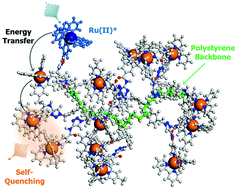Ru(bpy)32+ derivatized polystyrenes constructed by nitroxide-mediated radical polymerization. Relationship between polymer chain length, structure and photophysical properties†
Abstract
A series of polystyrene-based light harvesting polymers featuring pendant polypyridyl ruthenium complexes has been synthesized. The polymer backbones were prepared by nitroxide-mediated radical polymerization with a variable average molecular weight (Mn) ranging from ∼5500 to ∼24 000 g mol−1. Pendant Ru(II) polypyridyl complexes were grafted to the polymer backbone by azide–alkyne click chemistry to afford chromophore loaded polymers. The resulting polystyrene-based polychromophores with pendant Ru(II) polypyridyl complexes (PS-Ru) were characterized by nuclear magnetic resonance and infrared spectroscopy, confirming the high efficiency of the click grafting. The photophysical and electrochemical properties of the series of PS-Ru polymers were characterized in solution and investigated as a function of polymer chain length and solvent. The electrochemical properties of PS-Ru maintained the characteristics of the individual Ru(II) polypyridyl units. Emission quantum yield and lifetime studies reveal that the metal-to-ligand charge transfer (MLCT) excited states are quenched to a variable extent depending on the molecular weight of the polymers, consistent with intramolecular energy transfer and self-quenching in polymers with longer chain lengths. To support the synthetic effort, molecular dynamics simulations of the polypyridyl ruthenium derivatized polystyrenes in different solvents were conducted.


 Please wait while we load your content...
Please wait while we load your content...